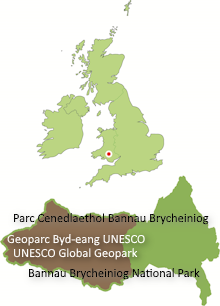Natural processes and human influence are set to alter Wales’ future history and indeed that of Fforest Fawr Geopark.
In the short term it seems likely that changes in Wales’ climate are most likely to have an impact on this landscape.
A wetter and warmer Wales
Climatologists predict a wetter and warmer Wales over the next few decades with much of the rain coming in heavier bursts than in recent times. Bigger and more frequent floods would affect the built environment – where we live and work and how we travel.
Torrential rain also has a lasting impact on the natural landscape as over-saturated slopes fail catastrophically – several small landslides occurred in the Geopark during the heavy rains of early September 2008.
There are predicted to be fewer days of frost and snow – these have already decreased markedly in the 50 years since the middle of the 20th century. Such changes affect the (semi-)natural vegetation of the uplands.
Greenhouse Earth
A warmer world due to higher levels of carbon dioxide in the atmosphere will have different global, regional and local effects. North west Europe is one of those regions which is currently predicted to get off most lightly.
Polar regions are expected to warm most rapidly – a trend already dramatically observed in the high Arctic. The consequences centuries ahead of the melting of large parts of the Greenland and Antarctic ice-caps due to higher temperatures are alarming. The collapse of the Greenland ice-cap would result in a rise in world-wide sea-levels of around 7m. The total collapse of the Antarctic ice-sheet would add another 65m to that rise! Neither ice-cap is a permanent feature of the Earth’s surface. Current predictions from the Intergovernmental Panel on Climate Change (IPCC) do not foresee this happening for a while yet!
Return of the ice?
There is no reason to suspect that we are not currently living in an interglacial period. There have been a series of alternating cold and warm periods over the last 2 million years or so and the current warm period might be expected in the normal course of things to give way to another ice age in a few thousand years. Whether this does happen or not would appear to hang on what effects human activity continues to have on world climate.
Prospects for the distant future
Over the last 600 million years, the British Isles have made a several thousand mile journey from near the south pole to their current latitude. This northward drift looks set to continue into the future.
The Atlantic Ocean continues to widen at a few centimetres each year and in the very long term this will cease and, as all previous oceans have done, it will begin to close. A subduction zone might become established off the coast of the British Isles and volcanic activity once again become a feature of this region.
Final destination
Eventually the Earth’s internal heat engine will stop working. As convective cells in the Earth’s mantle slow to a stop so plate tectonic processes that have underpinned the planet’s development over more than 3000 million years will cease and the plates will ‘lock-up’.
There will be no more mountain chains uplifted as continents cease to collide and the Earth’s relief will gradually become more subdued. Impact by extraterrestrial bodies will become the main agent of change just as they are on the Moon and Mars today where plate tectonic activity does not constantly renew those worlds’ surfaces.
The long term fate of our Sun is to swell up to become a ‘red giant’ star at which point Earth’s oceans will be boiled off, followed shortly by the rocky crust itself. All that will be left will be a charred remnant devoid of life and activity. But that’s billions of years in the future yet so for now let’s just enjoy the dynamic and fascinating planet that we inhabit today!



